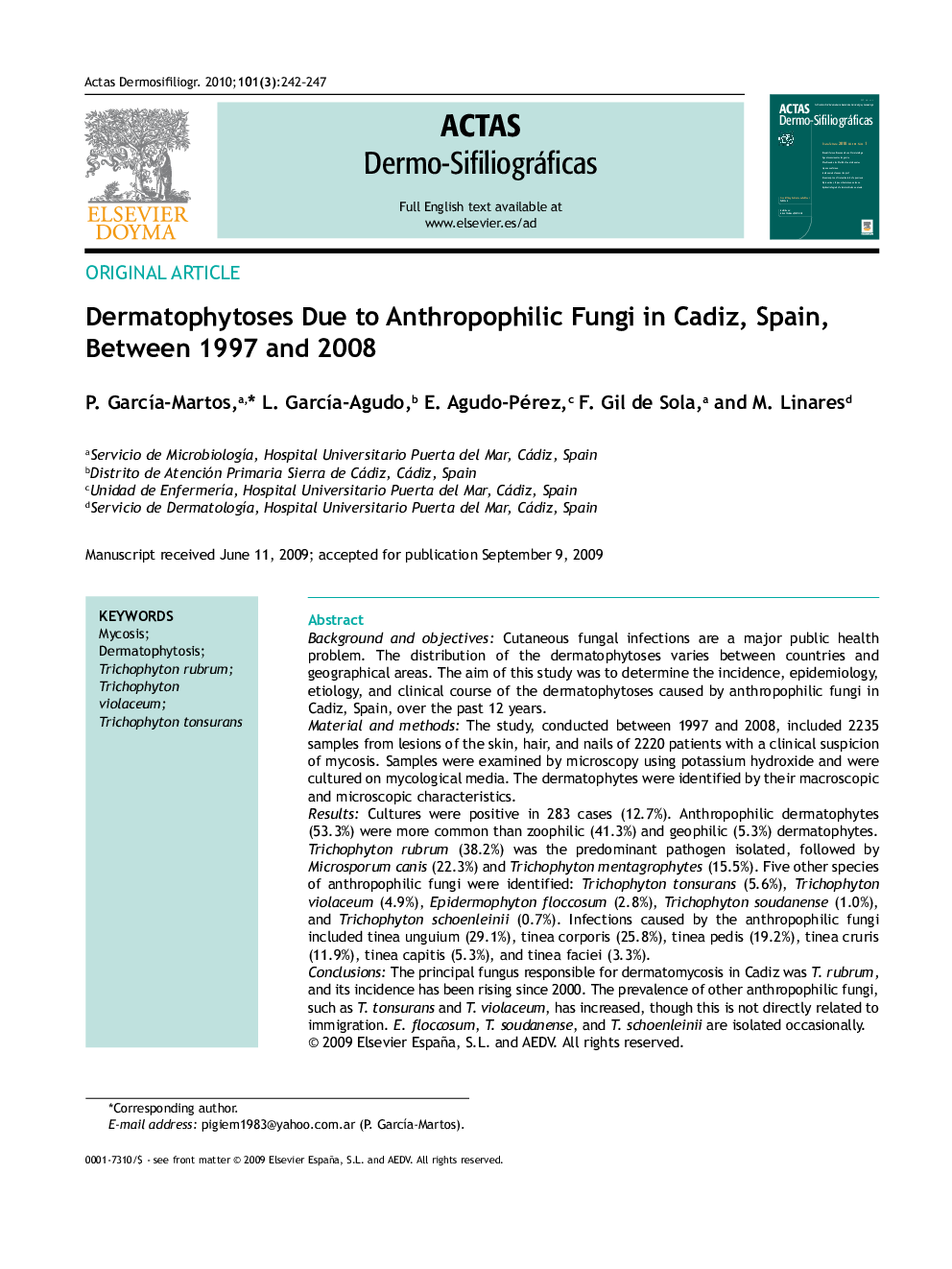| Article ID | Journal | Published Year | Pages | File Type |
|---|---|---|---|---|
| 3183129 | Actas Dermo-Sifiliográficas (English Edition) | 2010 | 6 Pages |
Background and objectivesCutaneous fungal infections are a major public health problem. The distribution of the dermatophytoses varies between countries and geographical areas. The aim of this study was to determine the incidence, epidemiology, etiology, and clinical course of the dermatophytoses caused by anthropophilic fungi in Cadiz, Spain, over the past 12 years.Material and methodsThe study, conducted between 1997 and 2008, included 2235 samples from lesions of the skin, hair, and nails of 2220 patients with a clinical suspicion of mycosis. Samples were examined by microscopy using potassium hydroxide and were cultured on mycological media. The dermatophytes were identified by their macroscopic and microscopic characteristics.ResultsCultures were positive in 283 cases (12.7%). Anthropophilic dermatophytes (53.3%) were more common than zoophilic (41.3%) and geophilic (5.3%) dermatophytes. Trichophyton rubrum (38.2%) was the predominant pathogen isolated, followed by Microsporum canis (22.3%) and Trichophyton mentagrophytes (15.5%). Five other species of anthropophilic fungi were identified: Trichophyton tonsurans (5.6%), Trichophyton violaceum (4.9%), Epidermophyton floccosum (2.8%), Trichophyton soudanense (1.0%), and Trichophyton schoenleinii (0.7%). Infections caused by the anthropophilic fungi included tinea unguium (29.1%), tinea corporis (25.8%), tinea pedis (19.2%), tinea cruris (11.9%), tinea capitis (5.3%), and tinea faciei (3.3%).ConclusionsThe principal fungus responsible for dermatomycosis in Cadiz was T. rubrum, and its incidence has been rising since 2000. The prevalence of other anthropophilic fungi, such as T. tonsurans and T. violaceum, has increased, though this is not directly related to immigration. E. floccosum, T. soudanense, and T. schoenleinii are isolated occasionally.
ResumenIntroducción y objetivosLas infecciones cutáneas producidas por hongos constituyen un importante problema de salud pública. La distribución de las dermatofitosis varía en diferentes países y áreas geográficas. El objetivo de este estudio ha sido determinar la epidemiología, etiología y evolución de las dermatofitosis por hongos antropofílicos en Cádiz durante los últimos 12 años.Material y métodosEl estudio se realizó de 1997-2008 sobre 2.235 muestras de lesiones de piel, pelo y uñas de 2.220 pacientes con sospecha clínica de micosis. Las muestras fueron analizadas mediante examen microscópico con hidróxido potásico y cultivo en medios micológicos. Los dermatofitos se identificaron de acuerdo con las características macroscópicas y microscópicas.ResultadosEl cultivo fue positivo en 283 muestras (12,7%). Los dermatofitos antropofílicos (53,3%) predominaron sobre los zoofílicos (41,3%) y geofílicos (5,3%). Trichophyton rubrum (38,2%) fue el patógeno más frecuente, seguido de Microsporum canis (22,3%) y Trichophyton mentagrophytes (15,5%). Se identificaron otras cinco especies de hongos antropofílicos: T. tonsurans (5,6%), T. violaceum (4,9%), Epidermophyton floccosum (2,8%), T. soudanense (1,0%) y T. schoenleinii (0,7%). Las infecciones por hongos antropofílicos fueron onicomicosis (29,1%), tiña corporal (25,8%), tiña del pie (19,2%), tiña crural (11,9%), tiña del cuero cabelludo (5,3%) y tiña facial (3,3%).ConclusionesEl principal responsable de dermatofitosis en Cádiz es Trichophyton rubrum. Su incidencia es ascendente desde el año 2000. Otros hongos antropofílicos como T. tonsurans y T. violaceum son cada vez más prevalentes, aunque no están directamente relacionados con la inmigración. Epidermophyton floccosum, T. soudanense y T. schoenleinii se aíslan ocasionalmente.
